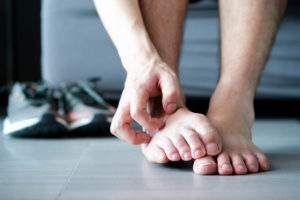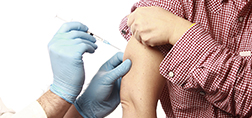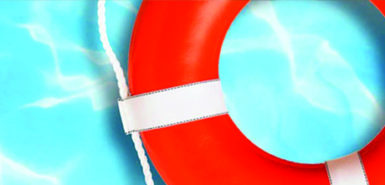
As young athletes head to the gym, field or wrestling mat, unlikely opponents may lie in wait.
Fungi. Viruses. Bacteria.
All can cause skin conditions that may spread as athletes bump into each other, walk through locker rooms or share equipment.
But with careful prevention, early detection and treatment, athletes can minimize the impact of these conditions.
“Most kids don’t want to be the kid that has ringworm or the kid that has athlete’s foot,” said Anna Ingersoll, a nurse and the manager of the Spectrum Health school health program. “But if you do have it, don’t be embarrassed to seek help.”
The quicker an athlete treats a condition, the less impact it may have on the athlete. It can also lessen the likelihood of the condition spreading to others, said Angela Oostema, MD, Spectrum Health family medicine specialist.
Here are tips for treating several conditions that can affect an athlete’s skin.
Heat rash
Heat rash is one of the most common skin conditions Ingersoll sees, especially during long practices on hot days.
Red clusters of pimples or small blisters appear, often in areas of friction, such as the armpits and thighs.
“Our skin is our first layer of defense,” Ingersoll said. “Heat rash is caused by friction. Rubbing breaks down the first layer of skin.”
To help prevent this, young athletes should avoid scented soaps in the shower and laundry. This can help avoid extra irritation.
“You really want to go with a nice soap, like Dove, that is not abrasive,” Dr. Oostema said. A gentle moisturizer, such as Cetaphil and Aveeno, also provides protection.
Switching from moisture-wicking fabric to cotton shirts can also help reduce rash or acne at friction points when sweaty.
Fungal infections
Ringworm, a skin condition caused by a fungus, can cause red, scaly cracked skin, often in a circular, ring shape. The condition can spread by way of sports contact, locker rooms and shower floors, Ingersoll said.
Ringworm infections on the feet and between the toes is referred to as athlete’s foot. In the groin area, it’s jock itch.
“Not every spot looks the same. It can be hard to diagnose initially,” Dr. Oostema said.
A doctor should evaluate any scalp fungal infections, as these can lead to abscesses or hair loss and require oral antifungal treatments, Dr. Oostema said.
For non-scalp fungal infections, parents can try treating ringworm infections with over-the-counter antifungal cream, powder or lotions.”
Viral infections
Warts, another common skin condition that affects athletes, are caused caused by a human papilloma virus—but not the same strain that causes cervical cancer.
Although warts often go away on their own, Dr. Oostema said people can try an over-the-counter gel or cream containing salicylic acid. A doctor can treat them with cryotherapy, using liquid nitrogen to destroy the cells.
Molluscum contagiosum is another skin condition that resembles warts. It causes small, flesh-colored spots, often with a central depression.
“It is very contagious,” Dr. Oostema said.
“Molluscum can occur anywhere except for the palms and soles of feet. Treatment is not always necessary, but we can use cryotherapy or other treatments like cantharidin.”
Some kids get bumps on the backs of their arms or face, often in clusters in skin creases. Doctors can treat this with cryotherapy.
Herpes simplex, the virus behind cold sores, can spread through contact sports. Wrestlers may know it as herpes gladiatorum, or mat herpes.
Skin lesions often occur around the mouth or lips, but can show up on the head, neck and shoulders—or anywhere, Dr. Oostema said. Open abrasions or wounds are particularly vulnerable to infection.
Because it may initially be confused with acne or other skin conditions, Dr. Oostema encourages parents to be familiar with the signs of a herpes simplex lesion.
“If they see lesions, we can treat them. It’s best to start the antiviral medication within 72 hours,” she said.
Bacterial infections
Bacteria that cause cellulitis—an infection of the skin—are also common, Dr. Oostema said.
“It’s really important that parents are watching for that very early,” she said.
The infection appears as a red, warm spot. If uncertain whether the cause is an insect bite or infection, Dr. Oostema said she advises drawing a line around the red area with a pen.
“If it’s an infection, it will increase in size. If it’s a bug bite, it will regress,” she said.
If a bacterial infection is suspected, she recommends seeing a medical provider for treatment.
“For bacterial infection, there should be dramatic improvement at 48 hours from the start of antibiotic treatment, but some cases take longer,” Dr. Oostema said.
If an abscess—a raised, tender boil beneath the skin—appears, a health care provider must drain it.
“It’s best to see a doctor if you think the infection is progressing,” she said.
If a patient has repeated abscesses caused by MRSA—methicillin-resistant staphylococcus aureus—Dr. Oostema advises washing with an antibacterial soap called Hibiclens to help reduce the load of skin bacteria.
Impetigo is another contagious bacterial infection. It’s especially common in young kids, but it can affect all ages.
Caused by group A streptococcus or staphylococcus aureus, it begins as tiny blisters that may leak fluid and form crusty yellowish brown scabs, often on exposed skin. Although it often appears on exposed skin around the nose, mouth, forearms and legs, it can occur anywhere on the body.
Health care providers treat impetigo with a topical antibiotic cream or oral antibiotics. Covering sores can help prevent spread.
Prevention tips
The Centers for Disease Control and Prevention recommends good wound care to help prevent bacterial skin infections:
- Clean minor cuts, blisters and scrapes with soap and water.
- Clean and cover draining or open wounds with clean, dry bandages.
- See a doctor for puncture and other deep or serious wounds.
- With an open wound or active infection, avoid spending time in hot tubs, pools, lakes, rivers and the ocean.
To further reduce the likelihood of skin infections, experts offer these tips:
- Don’t share towels.
- Avoid walking barefoot in a locker room or public shower.
- Keep feet dry. If playing two games in a day, switch to a clean pair of socks for the second.
- Keep fingernails and toenails short.
- Shower immediately after exercise.
- Consult a health care provider to learn when an athlete can safely return to the sport. An athlete can cover a wart during competition, for example, but should sit out with an active rash, herpes simplex or MRSA infection.
 /a>
/a>
 /a>
/a>
 /a>
/a>